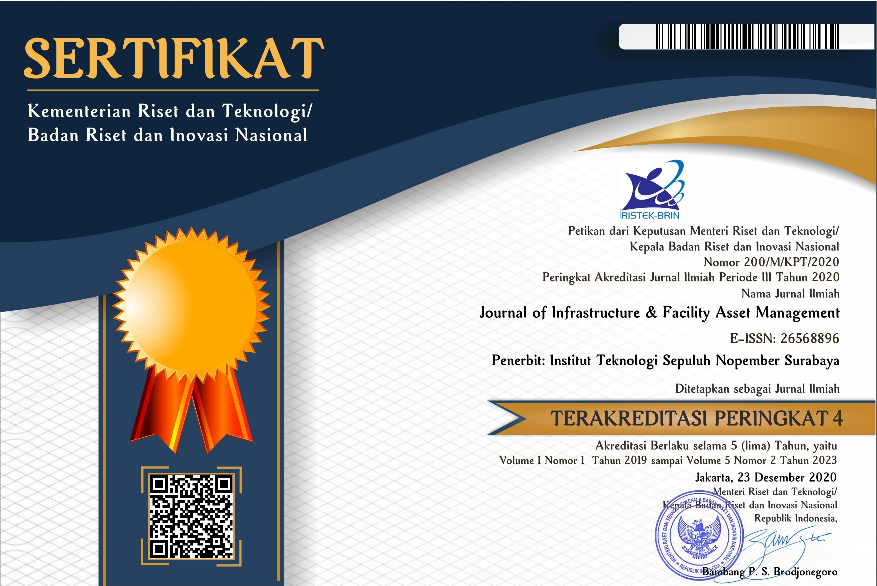Simulation of Concrete Slab Behavior to Explosion
Abstract
Special structure prone to explosion requires special material. Identification of special material is required to find the right concrete properties. Researching material behavior using explosion test is costly. Therefore, prediction using simulation is needed. In this study, we use ANSYS Workbench as a simulation program. The explosion test model comprised a non-reinforced slab 500×500×50 mm and TNT cube. It was found that the compressive strength minimum of the concrete slab that withstand the explosion of 30 grams TNT was 20 MPa. The Young modulus affects to the concrete behavior using default RHT Concrete properties. It had instability against modified concrete properties when performing numerical analysis.
Full Text:
PDFReferences
Al Bari, M. S., Ekaputri, J. J., F. & Ariatedja, J. B. (2019). Simulation of Steel Fibre Reinforced Concrete Behavior to Explosion. Final Project. Unpublished. Faculty of Civil, Environmental and Geo Engineering. Institut Teknologi Sepuluh Nopember. Surabaya.
BSN (2013). Persyaratan Beton Struktural untuk Bangunan Gedung. SNI 2847-2013. BSN - Badan Standarisasi Nasional.
FEMA (2003). Primer for Design of Commercial Buildings to Mitigate Terrorist Attacks. Risks Management Series. FEMA 427. FEMA – Federal Emergency Management Agency.
Koccaz, Z., Sutku, F. & Torunbalci, N. (2008). “Architectural and Structural Design for Blast Resistant Building”. The 14th Conference on Earthquake Engineering, October 12-17, 2018. Beijing.
Lee, H.-H. (2015). Finite Element Simulation with ANSYS Workbench 16. SDC Publication.
Nayel, A. G. & Abdel-mooty, M. (2017). "Numerical simulation of reinforced concrete panels under the effect of unconfined external detonations". 2nd International Conference on Structural Safety under Fire & Blast Loading CONFAB 2017. London. pp. 118-127.
Ngo, T., Mendis, P., Gupta, A. & Ramsay, J. (2007). "Blast Loading and Blast Effects on Structures - An Overview". EJSE Special Issue: Loading on Structures, pp. 76-91.
Remennikov, A. & Carolan, D. (2006). “Blast Effects and Vulnerability of Building Structures from Terrorist Attack”. Australian Journal of Structural Engineering, Vol. 7, No. 1, 2006.
Riedel, W., Kawai, N. & Kondo, K.-i. (2009). "Numerical Assessment for Impact Strength Measurements in Concrete Materials". International Journal of Impact Engineering, pp. 283-293.
Shi, Y., Hao, H. & Li, Z.-X. (2007). "Numerical simulation of blast wave interaction with structure columns". Shock Waves, pp. 113-133.
Suprayitno, H. & Soemitro, R.A.A. (2018). “Preliminary Reflexion on Basic Principle of Infrastructure Asset Management”. Jurnal Manajemen Aset Infrastruktur & Fasilitas, Vol. 2, No. 1, Maret 2018.
Suprayitno, H. & Soemitro, R.A.A. (2019). “Reflection on Basic View of Public Infrastructure for Infrastructure Asset Management in Indonesia”. Jurnal Manajemen Aset Infrastruktur & Fasilitas, Vol. 3, Suplemen 1, Juni 2019.
Tu, Z. & Lu, Y. (2010). "Modifications of RHT material model for improved numerical simulation of dynamic response of concrete". International Journal of Impact Engineering.
U.S. Department of Defense (2008). Structures to Resist The Effects of Accidental Explosions. UFC 3-340-02. U.S. Department of Defense.
Wang, F. et al. (2008). "Reinforced concrete slab subjected to close-in explosion". DYNAmore. Bamberg. pp. J - I - 21.
DOI: http://dx.doi.org/10.12962%2Fjifam.v1i2.5970
Refbacks
- There are currently no refbacks.
Visitor :
Flag Counter

Journal Of Infrastructure & Facility Asset Management by Institut Teknologi Sepuluh Nopember is licensed under a Creative Commons Attribution-ShareAlike 4.0 International License.





